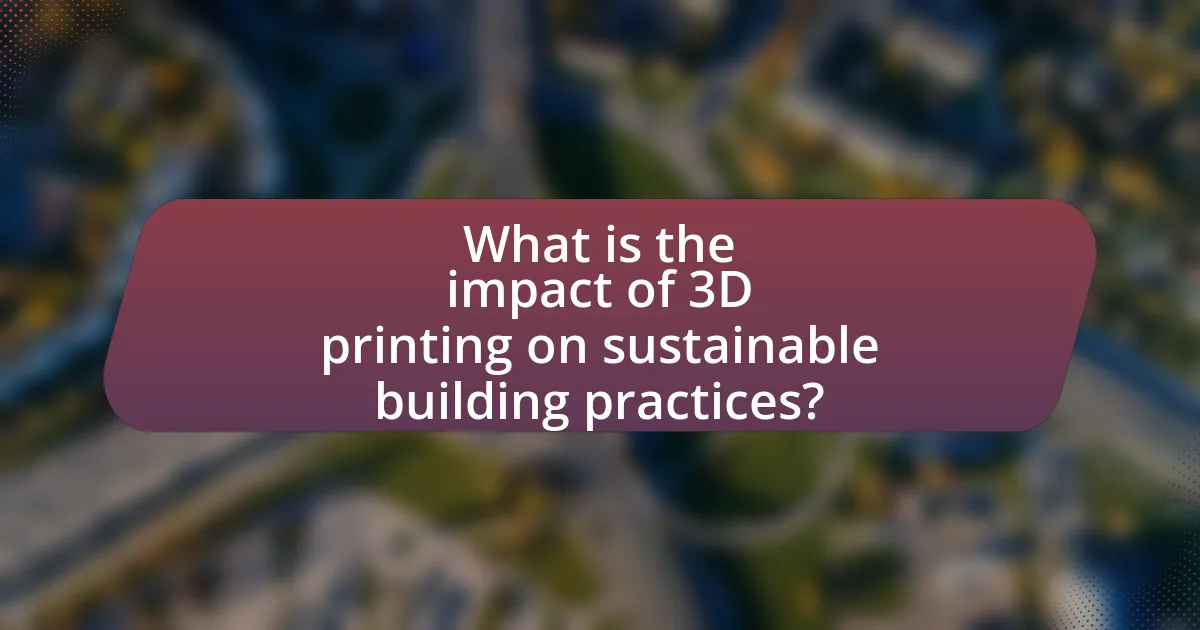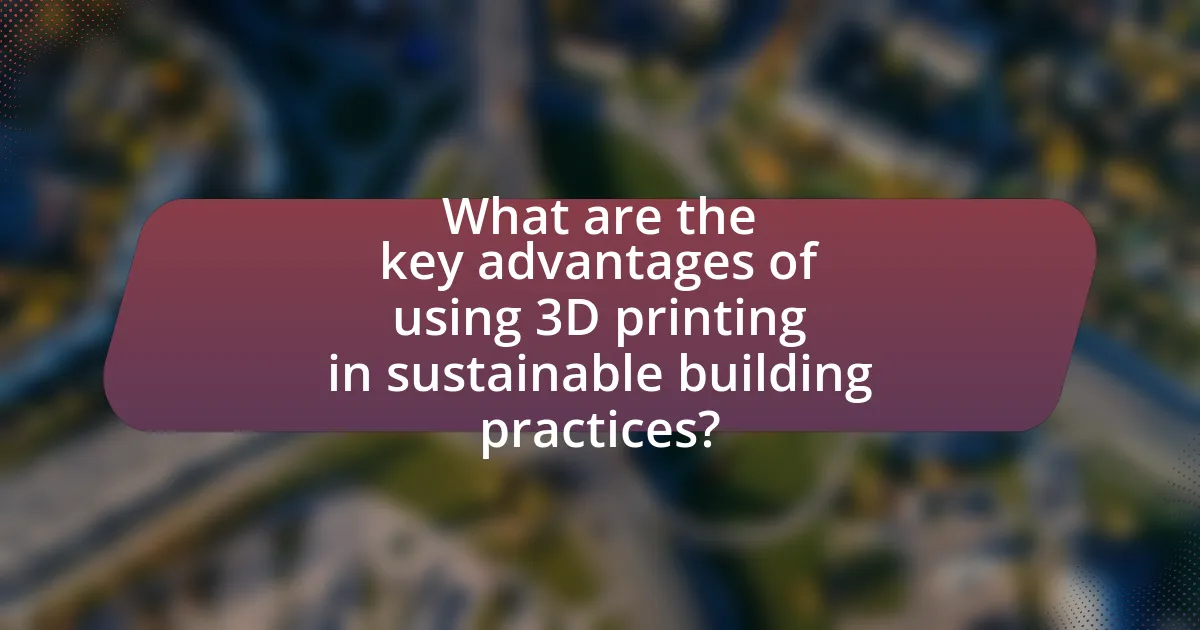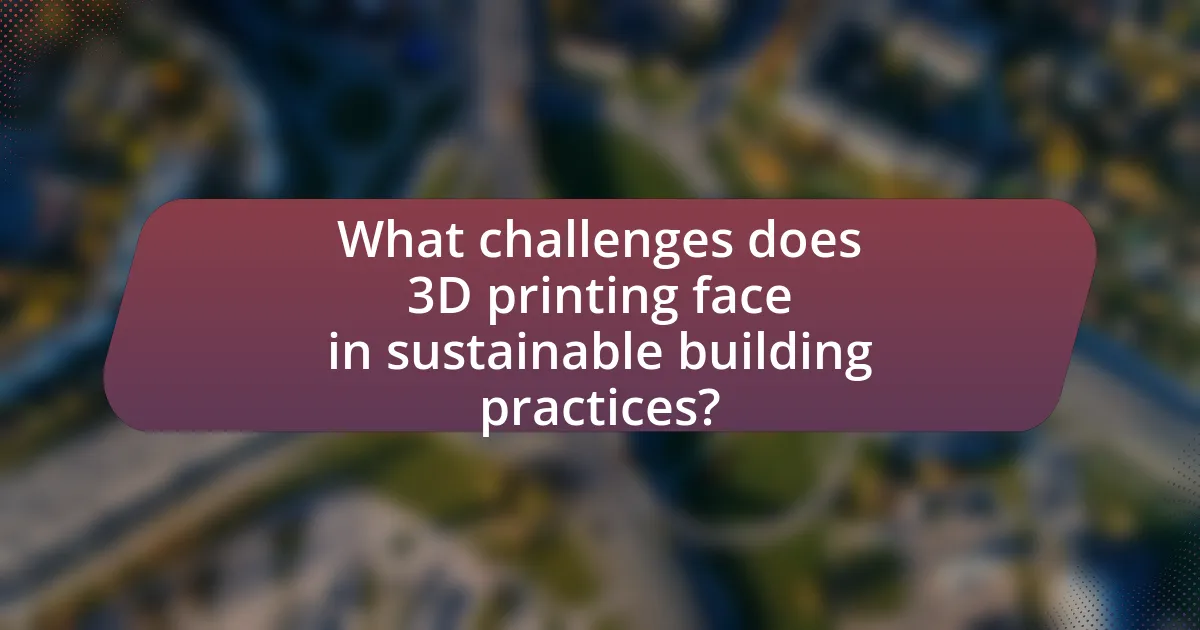The article examines the impact of 3D printing on sustainable building practices, highlighting its ability to reduce material waste and energy consumption significantly. Traditional construction methods often generate up to 30% waste, whereas 3D printing minimizes excess material through additive manufacturing techniques, potentially decreasing waste by up to 90%. The use of eco-friendly materials, such as bioplastics and recycled concrete, further enhances sustainability. Additionally, the article discusses the advantages of design flexibility, cost savings, and the challenges faced in regulatory compliance and material limitations, emphasizing the transformative potential of 3D printing in modern construction.

What is the impact of 3D printing on sustainable building practices?
3D printing significantly enhances sustainable building practices by reducing material waste and enabling the use of eco-friendly materials. Traditional construction methods often result in substantial waste, with estimates suggesting that up to 30% of materials can be discarded during the building process. In contrast, 3D printing utilizes additive manufacturing techniques, which build structures layer by layer, minimizing excess material. Additionally, 3D printing allows for the incorporation of recycled materials and bio-based substances, further promoting sustainability. Research from the University of Southern California indicates that 3D printing can decrease energy consumption in construction by up to 50%, highlighting its potential to lower the carbon footprint of building projects.
How does 3D printing contribute to sustainability in construction?
3D printing contributes to sustainability in construction by significantly reducing material waste and energy consumption. Traditional construction methods often result in up to 30% waste due to excess materials and inefficiencies, whereas 3D printing utilizes only the necessary amount of material, minimizing waste. Additionally, 3D printing can produce structures more quickly and with less energy compared to conventional building techniques, which can lead to lower carbon emissions. For instance, a study by the University of Southern California found that 3D printing can reduce the energy required for construction by up to 50%. This efficiency not only conserves resources but also promotes a more sustainable approach to building.
What materials are commonly used in 3D printing for sustainable buildings?
Common materials used in 3D printing for sustainable buildings include bioplastics, recycled concrete, and natural fibers. Bioplastics, derived from renewable sources like corn starch, offer a biodegradable alternative to traditional plastics. Recycled concrete utilizes waste materials from demolished structures, reducing landfill use and conserving natural resources. Natural fibers, such as hemp and bamboo, provide strong, lightweight options that are also renewable. These materials contribute to reducing the environmental impact of construction while promoting sustainability in building practices.
How does 3D printing reduce waste in the building process?
3D printing reduces waste in the building process by utilizing additive manufacturing techniques that create structures layer by layer, minimizing excess material. Traditional construction methods often involve cutting and shaping materials, which generates significant waste; in contrast, 3D printing only uses the exact amount of material needed for each component. Research indicates that 3D printing can reduce material waste by up to 90% compared to conventional building methods, as it allows for precise control over material usage and can incorporate recycled materials into the printing process.
Why is sustainable building important in today’s context?
Sustainable building is important in today’s context because it addresses environmental challenges while promoting resource efficiency. The construction and operation of buildings account for approximately 39% of global carbon emissions, highlighting the urgent need for sustainable practices to mitigate climate change. By utilizing eco-friendly materials and energy-efficient designs, sustainable buildings reduce waste and lower energy consumption, contributing to a healthier planet. Furthermore, sustainable building practices can enhance the quality of life for occupants through improved indoor air quality and reduced utility costs, making them a vital component of modern urban development.
What are the environmental benefits of sustainable building practices?
Sustainable building practices significantly reduce environmental impact by minimizing resource consumption and waste generation. These practices often incorporate energy-efficient designs, which can lead to a reduction in greenhouse gas emissions by up to 30% compared to conventional buildings. Additionally, sustainable buildings utilize renewable materials and promote recycling, which conserves natural resources and reduces landfill waste. For instance, the use of reclaimed wood and recycled steel not only lowers the demand for new materials but also decreases energy usage in production processes. Furthermore, sustainable buildings often feature improved water management systems, which can reduce water usage by 20-50%, contributing to the conservation of this vital resource.
How do sustainable buildings impact energy consumption?
Sustainable buildings significantly reduce energy consumption by incorporating energy-efficient designs and materials. These structures often utilize renewable energy sources, such as solar panels, and implement advanced insulation techniques that minimize heat loss. According to the U.S. Department of Energy, energy-efficient buildings can reduce energy use by 30% to 50% compared to conventional buildings. Additionally, sustainable buildings often feature smart technologies that optimize energy use, further decreasing overall consumption.

What are the key advantages of using 3D printing in sustainable building practices?
The key advantages of using 3D printing in sustainable building practices include reduced material waste, enhanced energy efficiency, and the ability to create complex designs with minimal resources. 3D printing technology allows for precise material usage, which can decrease waste by up to 90% compared to traditional construction methods. Additionally, structures created through 3D printing can be designed to optimize energy performance, leading to lower operational energy consumption. Furthermore, the technology enables the use of sustainable materials, such as recycled plastics and bio-based composites, contributing to a lower environmental impact.
How does 3D printing enhance design flexibility in construction?
3D printing enhances design flexibility in construction by allowing for the creation of complex geometries and customized structures that traditional methods cannot achieve. This technology enables architects and builders to design intricate shapes and forms, such as organic structures or unique facades, without the constraints of conventional materials and techniques. For instance, a study by the Massachusetts Institute of Technology demonstrated that 3D printing can produce components with varying densities and material properties, which can be tailored to specific structural requirements. This capability not only fosters innovation in architectural design but also optimizes material usage, contributing to more sustainable building practices.
What innovative architectural designs can be achieved through 3D printing?
Innovative architectural designs achievable through 3D printing include complex geometries, customized structures, and sustainable materials integration. 3D printing enables architects to create intricate forms that traditional construction methods cannot replicate, such as organic shapes and lattice structures that optimize material use and reduce waste. For instance, the ICON 3D-printed homes in Austin, Texas, showcase how this technology can produce affordable housing with unique designs while minimizing environmental impact. Additionally, projects like the 3D-printed bridge in Amsterdam demonstrate the capability to fabricate large-scale structures with precision, enhancing both aesthetic appeal and structural efficiency. These advancements highlight the transformative potential of 3D printing in modern architecture, particularly in promoting sustainable building practices.
How does design flexibility contribute to sustainability?
Design flexibility significantly contributes to sustainability by enabling the adaptation of structures to changing environmental conditions and user needs. This adaptability reduces waste and resource consumption, as buildings can be modified rather than demolished and rebuilt. For instance, research indicates that flexible design can lead to a 30% reduction in material waste during construction and renovation processes. By allowing for alterations in layout and function, design flexibility promotes efficient use of space and resources, ultimately supporting sustainable building practices.
What cost benefits does 3D printing offer for sustainable building projects?
3D printing offers significant cost benefits for sustainable building projects by reducing material waste and labor costs. The additive manufacturing process allows for precise material usage, minimizing excess and optimizing resources, which can lead to a reduction in overall project expenses. For instance, a study by the University of Southern California found that 3D printing can reduce construction costs by up to 50% compared to traditional methods due to decreased labor requirements and efficient material utilization. Additionally, 3D printing can expedite the construction timeline, further lowering costs associated with project delays and resource allocation.
How does 3D printing lower labor costs in construction?
3D printing lowers labor costs in construction by automating the building process, which reduces the need for manual labor. Traditional construction methods often require a large workforce for tasks such as bricklaying, framing, and finishing, whereas 3D printing can produce entire structures or components with minimal human intervention. For instance, a study by the University of Southern California found that 3D printing can reduce labor costs by up to 50% due to decreased labor hours and the ability to produce complex designs without additional labor. This efficiency not only cuts costs but also accelerates project timelines, further enhancing economic benefits in the construction industry.
What are the long-term financial savings associated with 3D printed buildings?
Long-term financial savings associated with 3D printed buildings include reduced construction costs, lower labor expenses, and decreased material waste. 3D printing technology can cut construction costs by up to 50% compared to traditional methods, as it minimizes the need for extensive labor and allows for faster project completion. Additionally, the precision of 3D printing reduces material waste by approximately 30%, leading to further savings on raw materials. These factors collectively contribute to significant long-term financial benefits for developers and property owners.

What challenges does 3D printing face in sustainable building practices?
3D printing faces several challenges in sustainable building practices, primarily related to material limitations, energy consumption, and regulatory hurdles. The materials used in 3D printing, such as plastics and concrete, often have environmental impacts due to their production processes and end-of-life disposal issues. For instance, traditional concrete production is responsible for approximately 8% of global carbon dioxide emissions. Additionally, the energy required for 3D printing processes can be significant, especially when using high-temperature methods, which may negate some sustainability benefits. Regulatory frameworks also lag behind technological advancements, creating barriers for widespread adoption in construction. These challenges hinder the full integration of 3D printing into sustainable building practices.
What regulatory hurdles exist for 3D printed construction?
Regulatory hurdles for 3D printed construction include a lack of standardized building codes, insufficient safety regulations, and challenges in obtaining permits. Many jurisdictions have not yet developed specific guidelines for 3D printed structures, leading to uncertainty in compliance. For instance, the International Code Council has acknowledged the need for updated codes to address the unique aspects of additive manufacturing in construction. Additionally, existing zoning laws may not accommodate the unconventional designs that 3D printing allows, further complicating the approval process. These regulatory gaps can hinder the adoption of 3D printing technologies in the construction industry.
How do building codes affect the adoption of 3D printing?
Building codes significantly influence the adoption of 3D printing in construction by establishing the regulatory framework that governs safety, structural integrity, and material standards. These codes can either facilitate or hinder the integration of 3D printing technologies, as they often require compliance with traditional construction methods that may not align with the innovative processes of 3D printing. For instance, the International Building Code (IBC) outlines specific requirements for materials and construction practices, which can limit the use of novel materials typically employed in 3D printing. Additionally, local jurisdictions may have varying interpretations of these codes, leading to inconsistencies that can deter investment in 3D printing technologies. Therefore, the alignment of building codes with the capabilities of 3D printing is crucial for its widespread adoption in sustainable building practices.
What safety concerns are associated with 3D printed structures?
Safety concerns associated with 3D printed structures include structural integrity, material toxicity, and fire safety. Structural integrity can be compromised due to layer adhesion issues, leading to potential failures under load. Studies have shown that certain 3D printing materials may release harmful volatile organic compounds (VOCs) during the printing process, posing health risks to workers and occupants. Additionally, the flammability of some materials used in 3D printing raises concerns about fire safety, as inadequate fire resistance can lead to rapid spread in case of a fire. These factors highlight the need for thorough testing and adherence to safety standards in the use of 3D printed structures.
How can the industry overcome barriers to implementing 3D printing in construction?
The industry can overcome barriers to implementing 3D printing in construction by investing in research and development to enhance technology and materials. This investment can lead to improved printing techniques, which have been shown to reduce waste and lower costs; for instance, a study by the Massachusetts Institute of Technology found that 3D printing can decrease material usage by up to 60%. Additionally, establishing regulatory frameworks that support innovation while ensuring safety standards can facilitate wider adoption. Collaboration among stakeholders, including architects, engineers, and policymakers, is essential to share knowledge and best practices, as demonstrated by successful projects in Europe that have integrated 3D printing into their building processes.
What role do technological advancements play in addressing these challenges?
Technological advancements play a crucial role in addressing challenges in sustainable building practices through the implementation of 3D printing. This innovative technology enables the efficient use of materials, reducing waste by up to 60% compared to traditional construction methods. Additionally, 3D printing allows for the creation of complex structures that optimize energy efficiency and resource management, directly contributing to sustainability goals. For instance, a study by the Massachusetts Institute of Technology highlighted that 3D-printed buildings can be constructed in a fraction of the time and cost, while also minimizing the carbon footprint associated with conventional construction.
How can collaboration among stakeholders facilitate the adoption of 3D printing?
Collaboration among stakeholders can significantly facilitate the adoption of 3D printing by fostering knowledge sharing, resource pooling, and innovation. When architects, engineers, manufacturers, and policymakers work together, they can identify best practices and develop standards that enhance the efficiency and effectiveness of 3D printing technologies. For instance, a study by the National Institute of Standards and Technology found that collaborative efforts in the construction sector led to a 30% reduction in material waste through optimized designs enabled by 3D printing. This collaboration not only accelerates the integration of 3D printing into sustainable building practices but also encourages investment in research and development, ultimately driving broader acceptance and implementation of the technology.
What best practices should be followed when integrating 3D printing into sustainable building projects?
Best practices for integrating 3D printing into sustainable building projects include selecting eco-friendly materials, optimizing design for material efficiency, and implementing energy-efficient printing processes. Eco-friendly materials, such as recycled plastics or bio-based composites, reduce environmental impact and promote sustainability. Optimizing design involves using generative design software to minimize waste and enhance structural integrity, which can lead to reduced material usage by up to 30%. Energy-efficient printing processes, such as using renewable energy sources for powering printers, further decrease the carbon footprint of the construction process. These practices collectively contribute to the sustainability goals of building projects while leveraging the advantages of 3D printing technology.
How can project managers ensure quality in 3D printed construction?
Project managers can ensure quality in 3D printed construction by implementing rigorous quality control measures throughout the project lifecycle. This includes establishing clear specifications for materials and processes, conducting regular inspections during the printing process, and utilizing advanced monitoring technologies to track the performance of the 3D printing equipment. For instance, studies have shown that real-time monitoring can detect deviations in material properties, which can lead to immediate corrective actions, thus maintaining structural integrity and compliance with safety standards. Additionally, training team members on best practices in 3D printing and adhering to industry standards, such as those set by ASTM International, further reinforces quality assurance in construction projects.
What strategies can be employed to maximize sustainability in 3D printed buildings?
To maximize sustainability in 3D printed buildings, strategies include using eco-friendly materials, optimizing design for energy efficiency, and implementing waste reduction techniques. Eco-friendly materials, such as recycled plastics or bio-based composites, reduce the carbon footprint associated with traditional construction materials. Optimizing design through techniques like passive solar heating and natural ventilation enhances energy efficiency, leading to lower operational energy consumption. Additionally, employing waste reduction techniques, such as minimizing excess material during the printing process and reusing leftover materials, contributes to a more sustainable building lifecycle. These strategies collectively support the goal of reducing environmental impact in the construction industry.





